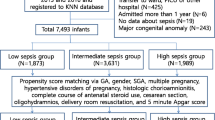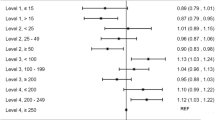Abstract
OBJECTIVE: To describe and analyze outcomes in very-low-birth-weight (VLBW) infants treated in 11 Neonatal Intensive Care Units (NICUs) from four South American countries. This study is the first of a multination collaboration and can serve as a baseline for future quality and resource utilization efforts.
STUDY DESIGN: Biodemographic data and multiple outcome measures were prospectively collected from October 1997 until August 1998. A logistic regression model was used to define risk factors in primary outcome measures, death, and bronchopulmonary dysplasia (BPD). Center differences were compared using χ-squared analysis.
RESULTS: In 385 VLBW infants enrolled, mortality rate was 27%, with a range from 11% to 51% among NICUs. A lower BW, lower gestational age (GA), lack of antenatal steroids (AS), and air leaks (AL) were associated with increased risk of death. A lower BW, lower GA, AL, need for surfactant, necrotizing enterocolitis, and need for intubation were associated with increased risk of BPD.
CONCLUSION: This study provides actual information about VLBW infants' prognosis in a SA region. Mortality rate variability among NICUs may be explained by differences in population and resources, but also by lack of implementation of proven beneficial therapies such as AS administration.
This is a preview of subscription content, access via your institution
Access options
Subscribe to this journal
Receive 12 print issues and online access
$259.00 per year
only $21.58 per issue
Buy this article
- Purchase on Springer Link
- Instant access to full article PDF
Prices may be subject to local taxes which are calculated during checkout



Similar content being viewed by others
References
Ministerio de Salud, Chile. Anuario de Demografía Chile: Instituto Nacional de Estadísticas 1998
Schwarcz R, Fescina RH . Bajo peso al nacer y mortalidad neonatal en America Latina In: Pérez A, Donoso E, editors. Obstetricia Santiago, Chile: Editorial Mediterraneo 1999
Avery M, Tooley H, Keller J et al. Is chronic lung disease in low birth weight infants preventable? A survey of eight centers Pediatrics 1987 79: 26–30
Horbar JD, McAuliffe TL, Adler SM et al. Variability in 28-day outcomes for very low birth weight infants:an analysis of 11 neonatal intensive care units Pediatrics 1988 82: 554–9
Lemons JA, Bauer CR, Oh W et al. Very low birth weight outcomes of the National Institute of Health and Human Development Neonatal Research Network, January 1995 through December 1996 Pediatrics 2001 107: El
The Vermont–Oxford Trial Network: very low birth weight outcomes for 1990 Pediatrics 1993 91: 540–5
International Neonatal Network, Scottish Neonatal Consultants, Nurses Collaborative Study Group. Risk-adjusted and population-based studies of the outcome for high risk infants in Scotland and Australia Arch Dis Child Fetal Neonat Educ 2000 82: F118–23
An international classification of retinopathy of prematurity Pediatrics 1984 74: 127
Bancalari A, Abdenour G, Feller R, Gannon J . Bronchopulmonary dysplasia: clinical presentation J Pediatr 1979 95: 819–22
Papile L, Bursten J . Incidence and evolution of subependimal and intraventricular hemorrhage. A study of infants with birth weights less than 1500 g J Pediatr 1978 92: 529–34
NIH Consensus Conference. Effect of corticoid steroids for fetal maturation on perinatal outcomes JAMA, J Am Med Assoc 1995 413–8
Levinton LC, Goldenberg RL, Baker CS et al. Methods to encourage the use of antenatal corticoid steroid therapy for fetal maturation JAMA, J Am Med Assoc 1999 281: 46
The Osiris Collaborative Group. Early versus delayed neonatal administration of a synthetic surfactant — the judgement of Osiris Lancet 1992 340: 1363–9
Yost CC, Soll RF . Early versus delayed selective surfactant treatment for neonatal respiratory distress syndrome Cochrane Database Syst Rev 2000 CDoo1456: 1–17 [Review]
Spitzer AR, Fox WW . Positive pressure ventilation In: Goldsmith, Karotkin E, editors. Assisted Ventilation of the Neonate Philadelphia: WB Saunders 1996 167–86
Heicher DA, Kasting DS, Harrod JR . Prospective clinical comparison of two methods for mechanical ventilation of neonates: rapid rate and short inspiratory time versus slow rate and long inspiratory time J Pediatr 1981 98: 957–61
Barton L, Hodgman JE, Pavlova Z . Causes of death in the extremely low birth weight infant Pediatrics 1999 103: 446–51
Gaynes RP, Edwards JR, Jarvis WR, Culver DH, Tolson BS, Martone WJ the National Nosocomial Infections Surveillance System. Nosocomial infections among neonates in high risk nurseries in the United States Pediatrics 1996 98: 357–61
Moylan FM, Walker AM, Kramer SS, Todres ID, Shannon DC . The relationship of bronchopulmonary dysplasia to the occurrence of alveolar rupture during positive pressure ventilation Crit Care Med 1978 6: 140–2
Bjordlund LJ, Ingimarson J, Cursted T et al. Manual ventilation with a few large breaths compromises the therapeutic effect of subsequent surfactant replacement in immature lambs Pediatr Res 1997 42: 348
Acknowledgements
We thank Eduardo Bancalari for his advice in preparing this manuscript and Guillermo Marshall (PhD) and Luis Villaroel for statistical assistance.
Author information
Consortia
Additional information
Grupo Colaborativo Neocosur. From the Unidad de Neonatología Hospital de Clínicas “José de San Martín” Universidad de Buenos Aires, Argentina; Unidad de Neonatología Hospital Juan Fernández, Buenos Aires, Argentina; Unidad de Neonatología Hospital Italiano, Buenos Aires, Argentina; Primer Instituto Privado de Neonatología y Pediatría, Córdoba, Argentina; Unidad de Neonatología Hospital Lagomaggiore, Mendoza, Argentina; Unidad de Neonatología Hospital Clínico Universidad Católica, Santiago, Chile; Unidad de Neonatología Hospital Clínico Universidad de Chile, Santiago, Chile; Unidad de Neonatología Hospital Gustavo Fricke, Via del Mar, Chile; Unidad de Neonatología Hospital Sótero del Río, Santiago, Chile; Unidad de Neonatología Hospital Cayetano Heredia, Lima, Perú Recién Nacidos Facultad de Medicina, Montevideo, Uruguay.
Jose L. Tapia, MD, Departamento de Pediatría, Pontificia Universidad Católica de Chile, Casilla 114-D, Santiago, Chile
Departamento de Pediatría, Pontificia Universidad Católica de Chile, Casilla 114-D, Santiago, Chile
Rights and permissions
About this article
Cite this article
GRUPO COLABORATIVO NEOCOSUR. Very-Low-Birth-Weight Infant Outcomes in 11 South American NICUs. J Perinatol 22, 2–7 (2002). https://doi.org/10.1038/sj.jp.7210591
Published:
Issue Date:
DOI: https://doi.org/10.1038/sj.jp.7210591
This article is cited by
-
Reducing neonatal mortality and respiratory distress syndrome associated with preterm birth: a scoping review on the impact of antenatal corticosteroids in low- and middle-income countries
World Journal of Pediatrics (2021)
-
Efficacy and safety of surfactant replacement therapy for preterm neonates with respiratory distress syndrome in low- and middle-income countries: a systematic review
Journal of Perinatology (2016)
-
Effect of prophylactic CPAP in very low birth weight infants in South America
Journal of Perinatology (2016)
-
Neonatal outcomes of very preterm infants admitted to a tertiary center in Lithuania between the years 2003 and 2005
European Journal of Pediatrics (2011)
-
Determinants of survival in very low birth weight neonates in a public sector hospital in Johannesburg
BMC Pediatrics (2010)



